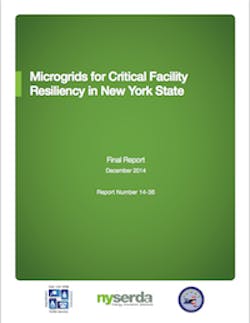In 2013, the New York State Legislature directed the New York State Energy Research and Development Authority (NYSERDA), the New York State Department of Public Service (DPS), and the New York State Division of Homeland Security and Emergency Services (DHSES) to develop recommendations regarding the establishment of microgrids in New York State (A3008D/S2508D-Part T). The primary objective of the study was to assess the practical feasibility of establishing critical facility microgrids to enhance the resiliency of facilities that provide critical public safety, health, and security support upon loss of the electric grid for an extended period (more than 72 hours) due to natural or manmade disasters.
For this study, critical facility microgrids is defined as a group of interconnected loads and distributed energy resources within clearly defined electrical boundaries that acts as a single controllable entity which can connect and disconnect from the surrounding utility grid and operate in both grid-connected or island mode.
The legislation required that the interagency team (the Project Team) develop recommendations in response to eight different topics.
